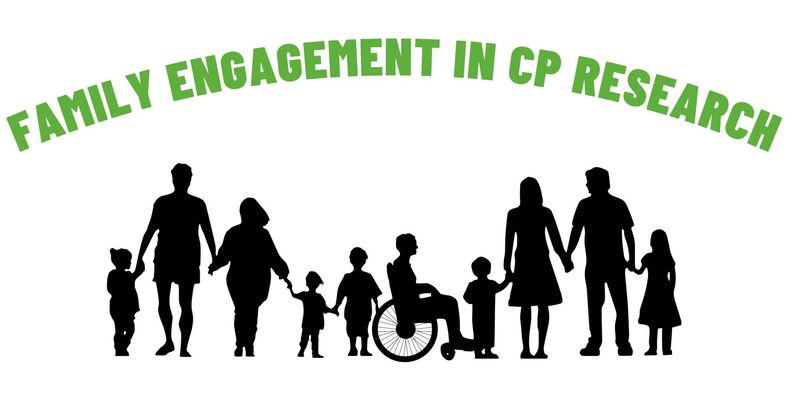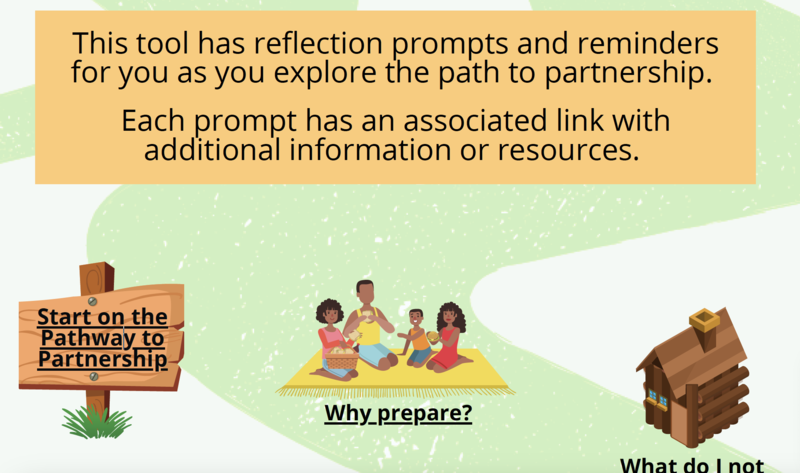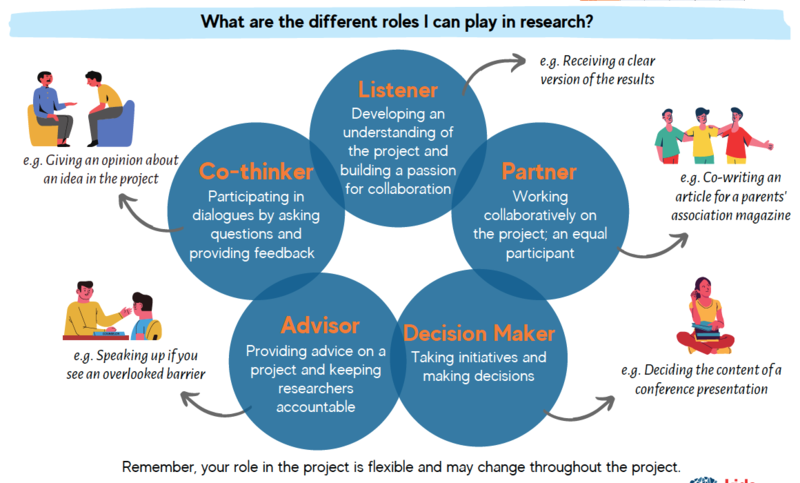Student Projects
As part of the requirements for the Family Engagement in Research (FER) course, researchers and family members are partnered together to create a knowledge translation (KT) tool. The purpose of the KT tools developed by students is to disseminate knowledge and information on patient and family engagement in childhood neurodevelopmental research. Examples of KT tools include infographics, webinars, podcasts, or any other means of sharing information. We encourage you to download and use these KT tools to support your engagement in research!
Websites
Authors: Fenna Walhain, Lynda Moore, Stacey Miller, and Robyn Evans Cunningham
Lynda Moore and Robyn Evans Cunningham are two parents of children with cerebral palsy (CP) and Fenna Walhain and Stacey Miller are CP researchers. Together, they share their thoughts on what you need to know when getting started with family engagement in research (FER). While they live and work in different parts of the world, they face different but also similar barriers. On this webpage, they share how they can overcome barriers and bring researchers and families together. They also designed stickers available on the website that can be used to share and get families and researchers involved in FER.
Webpage: https://super-lily.org/family-engagement-in-research/
.jpg)
The Dance Ability Movement offers inclusive dance classes for people of all abilities. Through their team of Dance Instructors, Occupational Therapists, Volunteers and Families, dancers participate at their studio to learn a variety of dance styles, and perform on stage with their peers. Through the program, dancers have the opportunity to make friends, be fit, and have fun! The success of the Dance Ability Movement classes relies on engaging parents in the program. Mallory Ryan (the Director of Quality & Improvement) recently participated in the Family Engagement in Research Certificate program through McMaster University, CanChild, and Kids Brain Health Network. In the course, Mallory was partnered with Chelsea Hand, a very proud mother of two amazing little boys. Her oldest son has a rare genetic condition and her youngest has cerebral palsy. As part of their final project in the course, Mallory and Chelsea developed a section on The Dance Ability Movement website featuring Family Engagement in Research (view here) and co-wrote a blog answering FAQ's on family engagement in research (read here).
Tools & Guidelines
Authors: Vina Mohabir, Gunjan Seth, Eki Okungbowa, and Karen McEwen.
Sharing your story in research can sometimes be difficult. As you embark on your engagement journey, start with this interactable web page developed by FER Grads Karen McEwen, Vina Mohabir, Gunjan Seth, and Eki Okungbowa. The KT Tool has as a series of reflection questions, tips, and tricks to help you as you prepare to share your story.
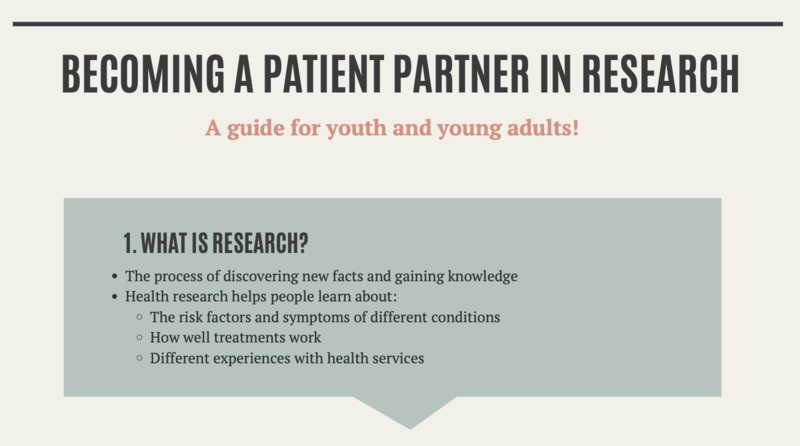
Authors: Claudia Tersigni, Tieghan Killackey, Kristy Allen and Marianna Healey
This tool is a youth's guide to becoming a patient partner in research. The tool was specifically tailored to focus on transition-aged youth because they are in a unique stage of life. At this time, they may be becoming more independent in navigating their condition(s) and making decisions about getting involved in research.
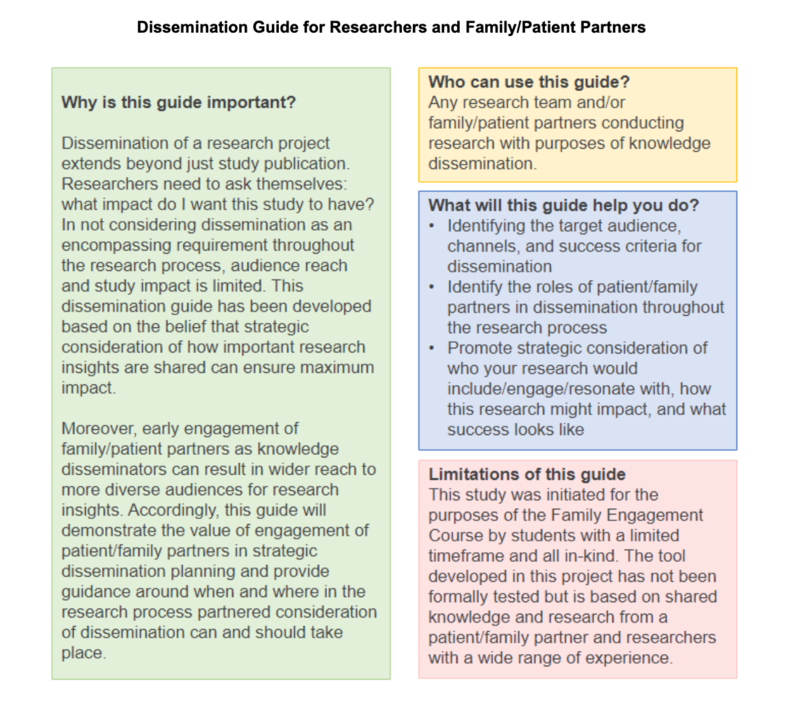
Authors: Derek Curtis, Eva Ta, and Alana Salsberg
Dissemination of a research project extends beyond just study publication. Dissemination is found throughout the research project - from proposal development to results analysis. This dissemination guide has been developed based on the belief that strategic consideration of how important research insights from both patient/family partners and research can be combined to ensure maximum impact.
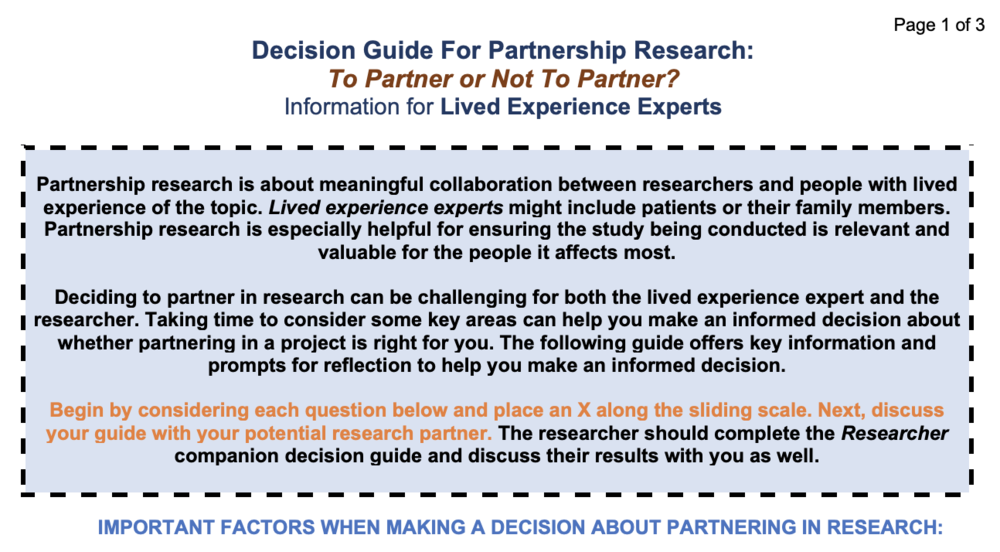
Authors: Kailyn Turner, Homira Osman, Mandy Young, Egmar Longo
Deciding to partner in research can be challenging for both lived experience experts and researchers. Taking time to consider some key factors can help individuals make an informed decision about whether partnering in a project is right for them. The Decision Guide For Partnership Research is a collaborative tool meant to be used by researchers and lived experience experts. The decision guide offers key information about important factors to consider when thinking about partnering in research and a series of sliding scale prompts for reflection. Each potential partner begins by considering the Researcher or Lived Experience Expert version individually. Next, the potential partners discuss their respective decision guides in a conversation and make a final decision about whether partnering in the research project is a good fit. This tool is available in English, Spanish, and Portuguese.
Please click the following links to download the documents:
The Decision Guide For Partnership Research for Lived Experience Expert:
The Decision Guide For Partnership Research for Researcher
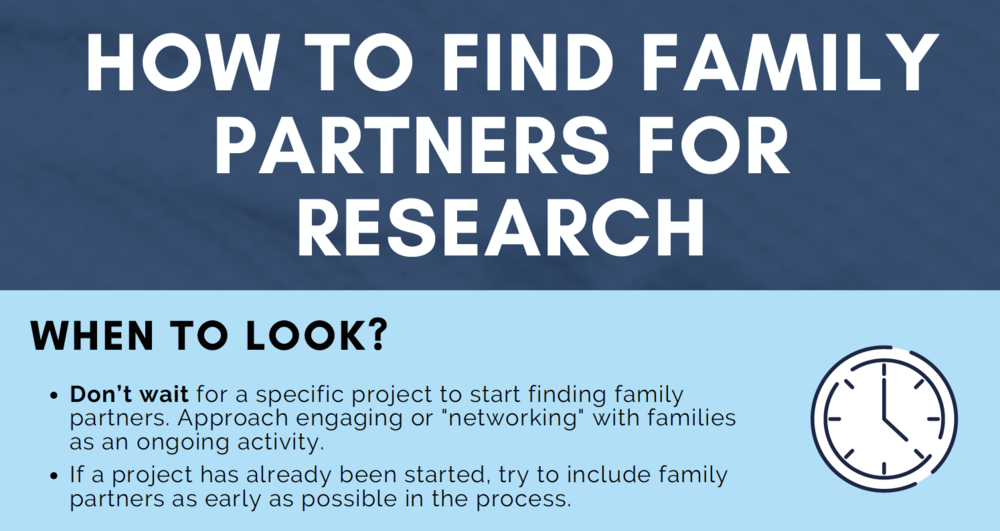
Authors: Avra Selick, Riddhi Desai, Zainab Albandri
The first challenge encountered by many researchers who want to conduct research in partnership with family members is finding family members to work with. This infographic provides researchers concrete tips and strategies on how to find family partners for research. The infographic reviews WHEN to look, WHERE to look, and HOW to look for family partners.
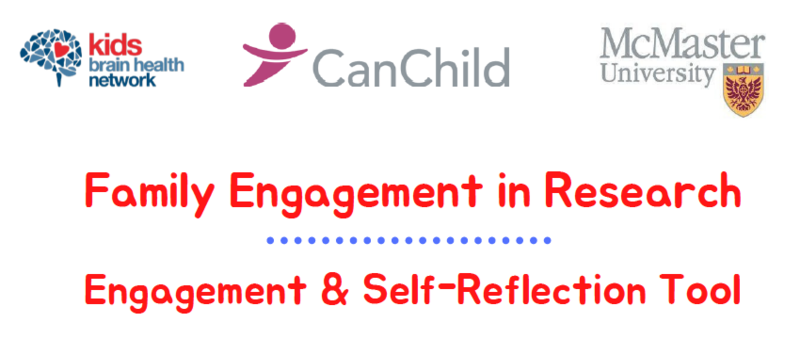
Authors: Amanda Binns, Lorrisa Dilay, and Heba Farag
These tools can be used to strengthen relationships within teams and enhance engagement through promoting self-reflection across members of a research team. There are three components to this tool: (1) a personal goal setting document, (2) a personal check-in document, and (3) a facilitation guide designed to promote discussions across group members about each member’s goals and reflections.
Please click the following links to download the documents:
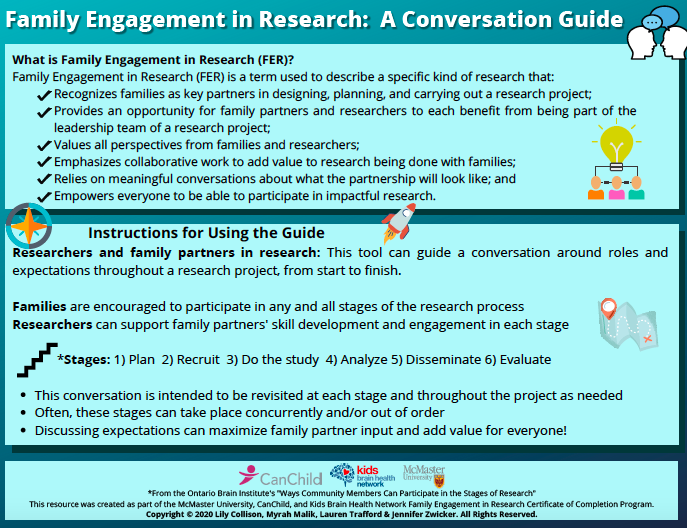
Authors: Jennifer Zwicker, Lauren Trafford, Myrah Malik, Lily Collinson
The "Family Engagement in Research: A Conversation Guide" is a collaborative tool meant for use by both researchers and family partners. This guide will walk researchers and partnered families through the necessary steps to designing and carrying out a research project, encouraging shared discussions around project hopes, goals, roles, and expectations. Included in the guide are: a definition of family engagement in research; instructions for using the guide; discussion questions at each stage of a research project; examples to provide suggestions for conducting high-quality, family-engaged research; and spaces to record and reflect on discussions.
Download the Conversation Guide
Download the Conversation Guide (fillable version)
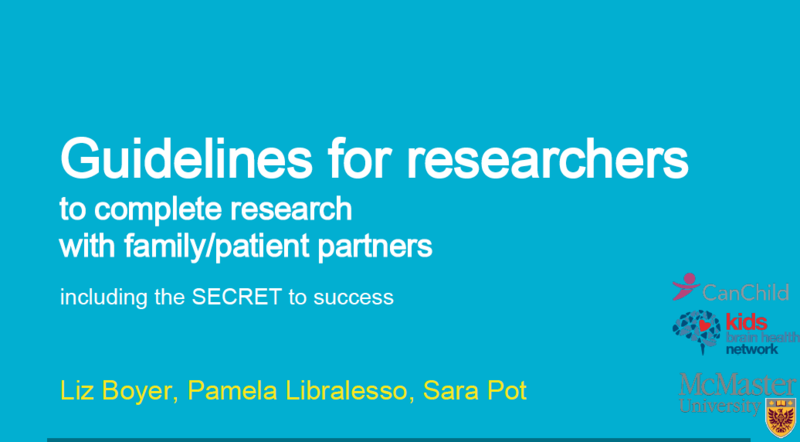
Authors: Elizabeth (Liz) Boyer, Pamela Libralesso, and Sara Pot
This ‘Guidelines for Researchers’ KT project was created to provide researchers with a brief introduction to family engagement in research. It’s a simple “How To” guide, ripe with resources, for researchers to start their first project with family/patient partners.
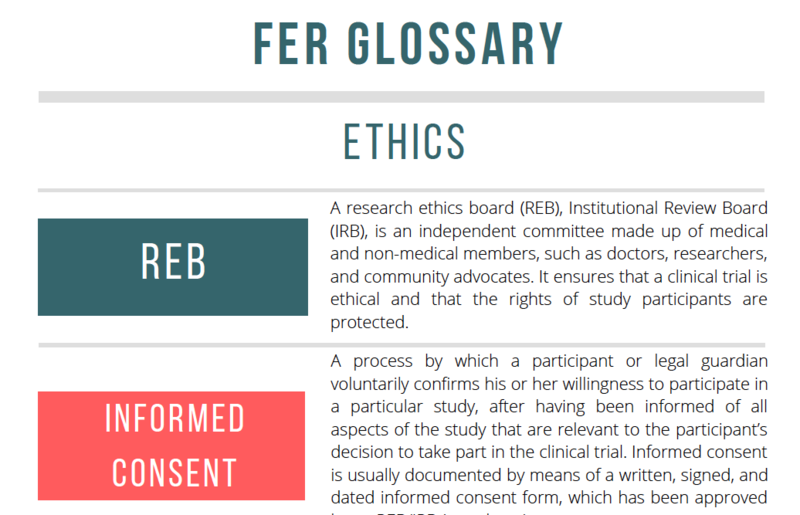
Authors: Ariel Taylor, Marion Knutson, Jeffrey McCrossin
This glossary is intended to support communication between researchers and family members that are partnering in research. It's normal for some family members to feel a bit lost in the jargon and slang researchers use regularly in their line of work. This document is not meant to be exhaustive or authoritative and some terms may require further explanation from a member of the research team. This glossary is a starting point for partners to develop a shared language.
Social Media
Authors: Clara Pina, Angelica Blais, Maeghan James, and Elise Bloch
The purpose of the @FER_InAction Twitter account is to highlight effective strategies, tools and experiences in family engagement in research targeted at both researchers and families. This page is designed intentionally as a Knowledge Translation tool and was created by Angelica Blais, Maeghan James, Elise Bloch and Clara Pina. Please feel free to follow the page and share it with your network.
Authors: Amanda Doherty Kirby, Jim Reeder, and Nicole Proudfoot
The Youth Engagement in Research Instagram account was created by Amanda Doherty-Kirby, James Reeder, and Nicole Proudfoot to increase awareness about how youth can engage in health-related research beyond being a participant. The @youth_in_research page shares knowledge about how youth engagement works, spotlights youth (both those with lived experience and researchers), and shares opportunities for youth to partner in research.
If you have an opportunity that you would like to share with young people, please e-mail feryer2020@gmail.com.
Learn more about Instagram and Youth Engagement in Research
Blogs
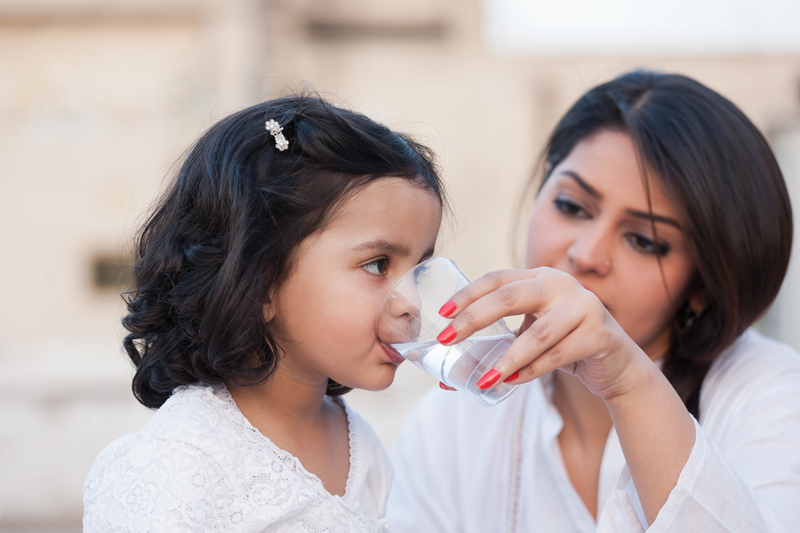
Authors: Megan Easton, Ralph Pot, Julie Gross, Alex Luther
This blog explores Family Engagement in Research (FER) and the issue of a lack of diversity among family partners in research. The authors report how diversity in FER is important as it ensures that a wide range of perspectives are represented and integrated in research. Unfortunately, there are barriers to diversity in FER which impede inclusivity and limit research opportunities for under-represented populations. The blog offers an overview of structural, attitudinal/cultural, and personal barriers experienced by researchers, families, and patients. In addition, the authors highlight strategies and next steps to increase diversity in FER. This blog is available on the Kids Brain Health Network website.
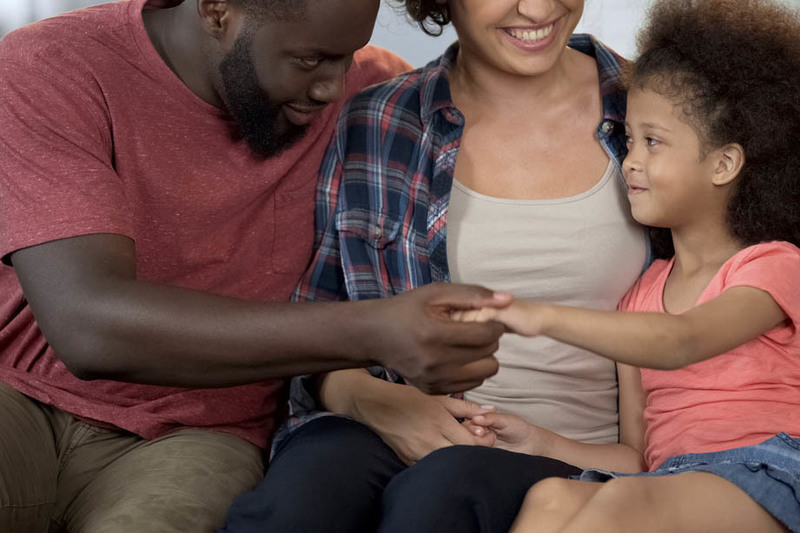
Authors: Genevieve Currie, Susan Heald, Zina Zaslawski
This blog post reflects on the importance of family engagement in research, as well as the challenges faced by both researchers and family members. In addition, the blog includes a list of important factors (e.g., values, expectations, and compensation) that researchers and family partners should discuss in order to help make the partnership successful. The need to evaluate the partnership is also highlighted as an essential component to improve the process of research engagement for both family partners and researchers.
Comics
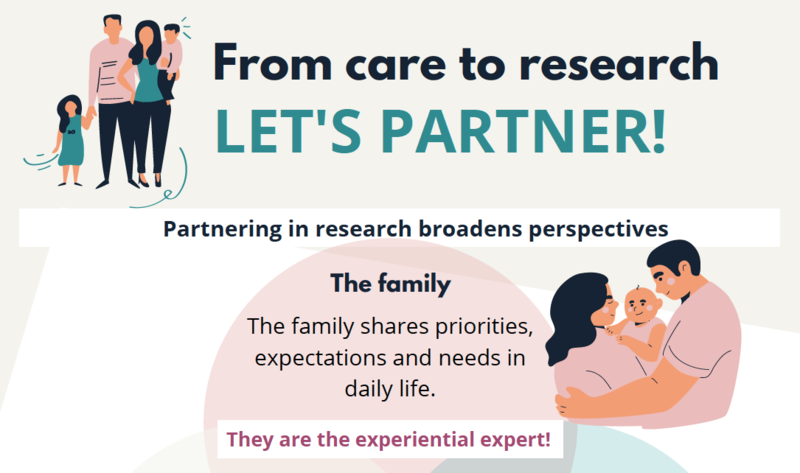
Authors: Sandrine Gagné-Trudel, Alain Chatelin, and Christelle Pons
This comic provides an example of the possibility of partnership in care and in research. It shows how research can be useful for decision-making in care and how the involvement of families is important in the development of knowledge. It emphasizes the value of research and the empowerment of families in this partnership.
Cette bande dessinée offre un exemple de partenariat en soins et en recherche. Elle montre comment la recherche peut être utile pour la prise de décision en contexte de soins, en plus de montrer comment l'engagement des familles est important pour le développement des connaissances. Elle met l'accent sur la valeur de la recherche et le pouvoir d’agir des familles dans ce partenariat.
Infographics

Authors: Samantha Noyek, Pamela Ruth Alberto-Flores, Joelle Fawcett-Arsenault, and Jennifer Cantwell
This infographic is designed to explain to families new to research, what partnership or engagement in research is and why it can be beneficial to get involved. The first page can be printed as a standalone document to be presented in hospital waiting rooms, schools, academic institutions etc. the QR present on the first page enables access to the subsequent, informative pages that provide information about research. There is an additional "insert your QR codes" page for other research teams to use our tool. They can embed their own QR codes and have their projects disseminated to families to promote engagement and partnership. This page could be used alongside the standalone first page (displayed in public and appropriates places) or remain as the last page of the informative content available online.
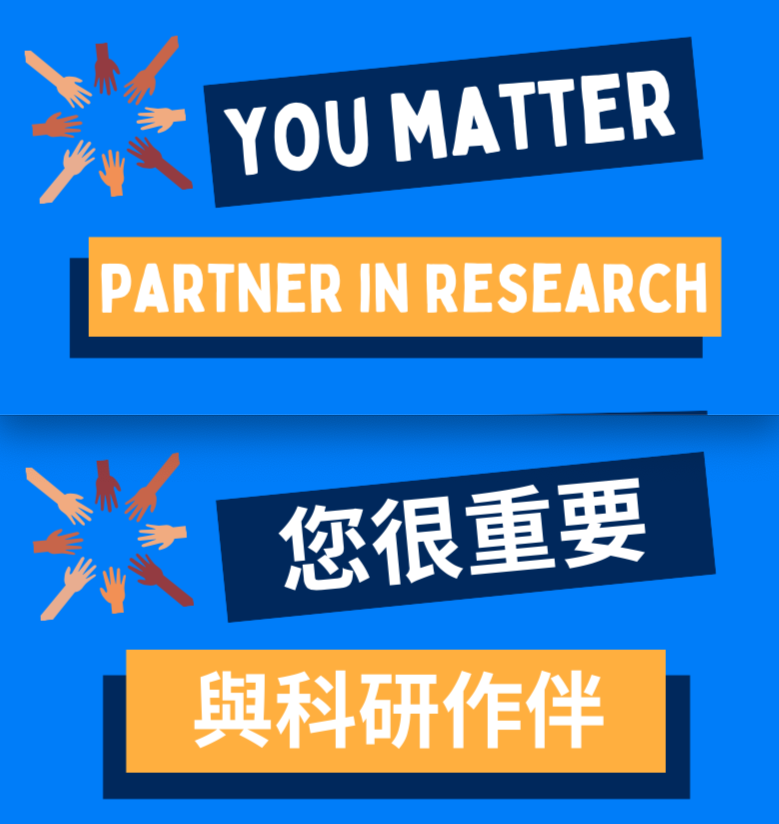
Authors: Katie Nickerson, Janet Mah, Mahdieh Yousef, Peter Welsh
The first infographic was created to increase immigrant family's awareness of research and engage in meaningful partnerships. This infographic for patients/families is available in English, Chinese, and Farsi. The second infographic inspires researchers to authentically include immigrant families in research and is available in English.
Download the first infographic (English, Chinese, Farsi)
Download the second infographic
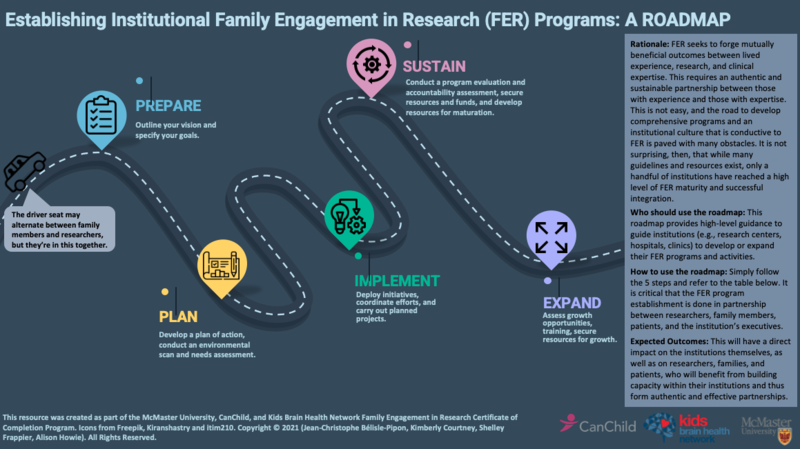
Authors: Jean-Christophe Bélisle-Pipon, Kimberly Courtney, Shelley Frappier, Alison Howie
This roadmap provides high-level guidance to guide institutions to develop or expand their family engagement in research (FER) programs and activities. The five key steps outlined in the roadmap are prepare, plan, implement, sustain, and expand; the accompanying table provides a more detailed explanation of what's involved at each step. Establishing a partnership between researchers, family members, patients, and the institution's executives is paramount to the success of FER programs.
Download Establishing Institutional FER Programs (presentation slides)
Download Establishing Institutional FER Programs (PDF)
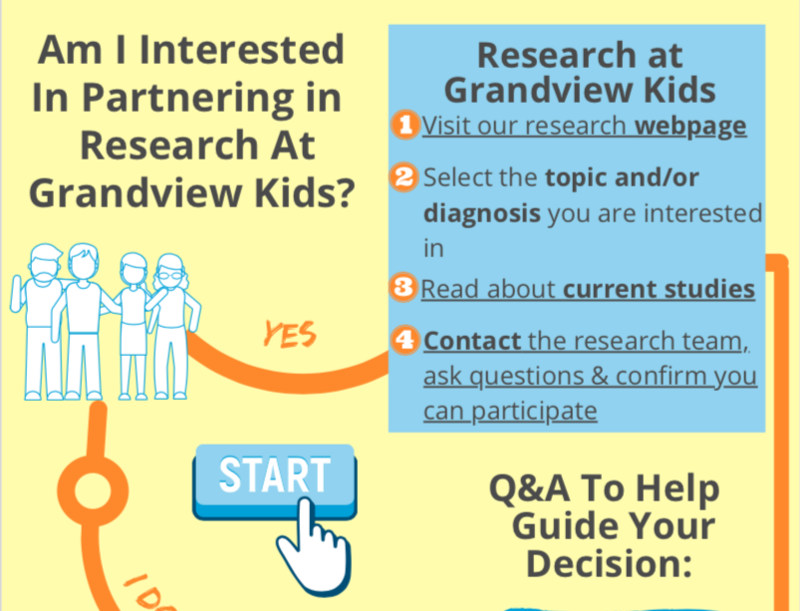
Authors: Andrea Belanger, Maritza Basaran, and Annette Neufeld
This visual integrated interactive KT road map allows families and patient partners to explore various aspects of research that might be relevant to them when deciding if and when they may become involved as a research partner. It is a tool that can be adapted and changed as knowledge changes over time. It incorporates previous KT tools to support families as they explore their role in research both now and in the future.
Download the KT Road Map (interactive)
Download the KT Road Map (printable)

Authors: Nicole MacKenzie, Jael Bootsma, Karen De Raeymaecker, and Anne Gaetan
This resource is to support trainees who are engaging families in their research for the first time. These resources are intended to support discussions of how to implement this practice in trainee research, but also provide recommendations on skill development and mentorship in the area. The infographic provides an overview of all the blocks, while the slide deck reviews each in more detail, with further discussion on how to use the tool.
Download Building Blocks of Partnerships (slide deck)
Download Building Blocks of Partnerships (infographic)
_Power_Dynamics_Infographic__Final_En.png)
Authors: Myriam Beauchamp, Christele Kandalaft-Cabrol, and Marie-Eve Bolduc
This tool supports researchers in implementing strategies to balance power dynamics in family engagement research. It describes the facilitators and barriers to building a reciprocal partnership relationship of trust. Our tool includes two documents: 1) an infographic that identifies barriers and facilitators to a balanced power relationship and 2) a checklist of strategies to facilitate a balanced power relationship. These documents can be used throughout the project.
Download Balancing Power Dynamics in Family Engaged Research
Télécharger Équilibrer les dynamiques de pouvoirs dans l’engagement des familles dans la recherche
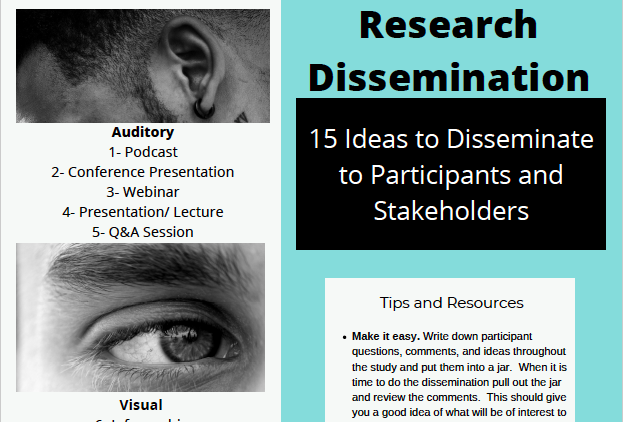
Authors: Kimberly Wynarczuk, Emily Bremer, Suzi Spelic, Julie Kuipery
This infographic breaks down 15 ideas to disseminate information to research participants and stakeholders. These dissemination strategies are categorized according to three types of educational materials, including auditory (e.g., podcasts, presentations, webinars, etc.), visual (e.g., videos, infographics, brochures, etc.), and textual (e.g., plain language summaries, blogs, social media posts, etc.).
Download the 15 Ways to Disseminate Research
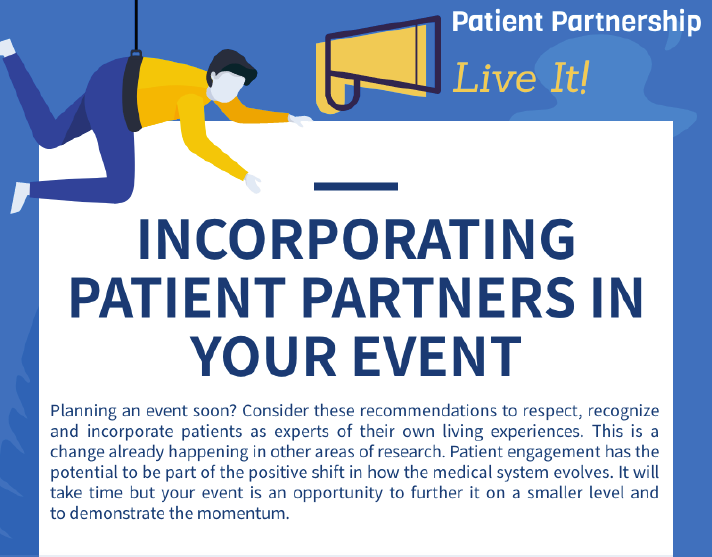
Authors: Vivian Wong and Gillian Robinson
A conference, summit, or workshop is the perfect opportunity to educate and inform a wide audience about the reality of the patient/family experience and the grounding that it brings to the medical community at so many levels.
You can bring this new learning to the forefront and have your conference incorporate and promote the much-needed perspective and input that the patient partners bring. Many from the medical and research community have incorporated this reality and are eager to further this. Getting together with patients and family members can be an invaluable opportunity to build on and with the people in attendance to integrate patient engagement and show that you are leading by example.
Here are some key ways you can ensure meaningful patient and family engagement at your next event. Our infographic gives tangible ways of incorporating the much-needed patient partner perspective from the inception of the conference to the debrief and in many creative and innovative ways in between.
Download Incorporating Patient Partners in your Event

Authors: Buse Bedir, Lynn Mendoza, Nancy Butcher, Annette Walker
This infographic gives readers a glimpse into the How, When, and Why of the benefits of integrated collaboration between researchers and "lived experience experts" known as patients and families during clinical trial design, conduct, analyses, and sharing of the findings of the trial.
Download the Patient and Family Engagement in Clinical Trials
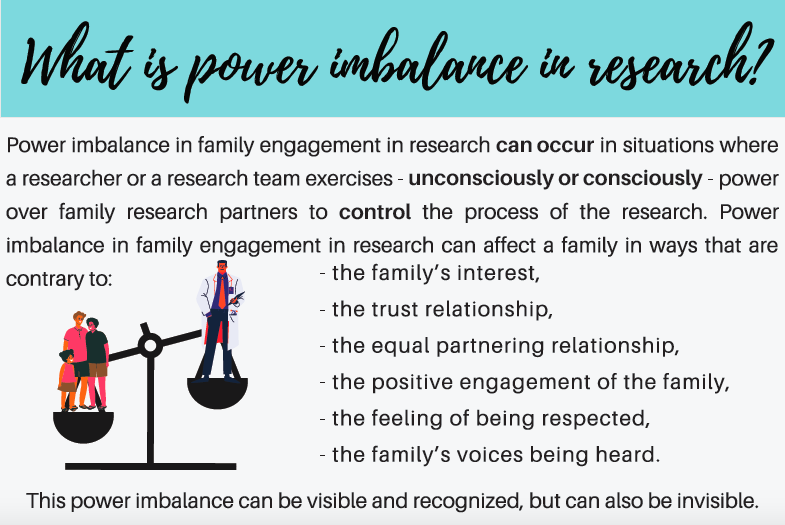
Authors: Berna Elias, Delphine Gaudin-Drouelle, Maude Champagne, Catrine Demers
This infographic provides information on how power imbalance can occur in family engagement in research, how it impacts the partnership in family engagement in research, what are the factors that the research team can look at when they want to detect power imbalance in research, and how to prevent power imbalance in research throughout the stages of research. The complementary list of questions supports the research team in their self-reflection practice to ensure a shared power environment for partnership in research.
Download the Power Imbalance Infographic (English Version)
Download the Reflective Questions (English Version)
Cette infographie donne des informations sur : 1) les rapports de pouvoir qui peuvent se produire lors de l’engagement des familles en recherche; 2) l'influence des rapports de pouvoir sur le partenariat; 3) les facteurs qui contribuent aux rapports de pouvoir qui peuvent être analysés par l'équipe de recherche afin de détecter cette dynamique et 4) les façons de prévenir l'apparition des rapports de pouvoir tout au long du processus de recherche. La liste complémentaire de questions soutient l'équipe de recherche dans sa pratique d’autoréflexion afin de permettre un partage des pouvoirs pour un environnement plus égalitaire lors de l'engagement des familles en recherche.
Download the Power Imbalance Infographic (French Version)
Download the Reflective Questions (French Version)
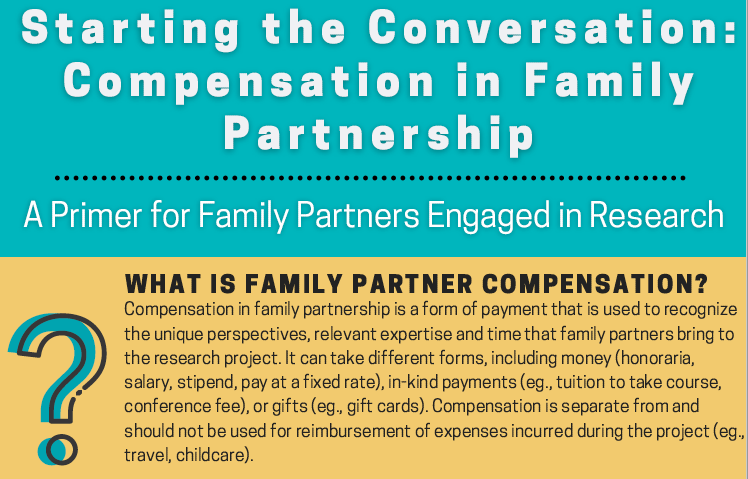
Authors: Steve Gentles, Hikmet Mawi, Samantha Schulz, Rachel Hornbeck
The purpose of this infographic primer is to introduce family partners to the topic of compensation for engagement in research activities. It specifically targets family partners to increase their level of comfort for participating in what can otherwise seem like an awkward conversation.
Download Starting the Conversation: Compensation in Family Partnership
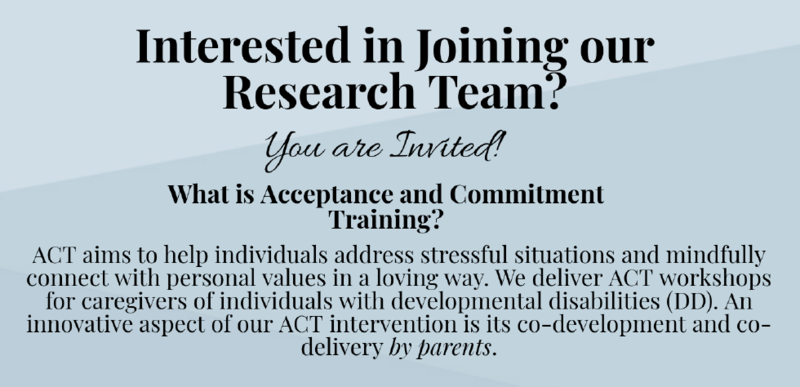
Author: Lee Steel and Bri Redquest
We offer Acceptance and Commitment Therapy (ACT) workshops to caregivers of people with disabilities to help improve their psychological wellbeing. A unique aspect of these workshops is that they are delivered by a clinician and a caregiver. Here is an example of a flyer that we created to help recruit caregivers to co-facilitate these ACT workshops.

Authors: Jaime Winkler, Chantelle Bouck, Erin Klein
The ethical research involving children falls under the obligation of investigators to serve and protect vulnerable individuals. Involving children in discussions and processes that directly impact their lives is important throughout the entire process. Equally important is that a child knows that they have the right to say that they no longer feel comfortable participating or answering the questions being asked.
Download the Right to Participate - Children in Research
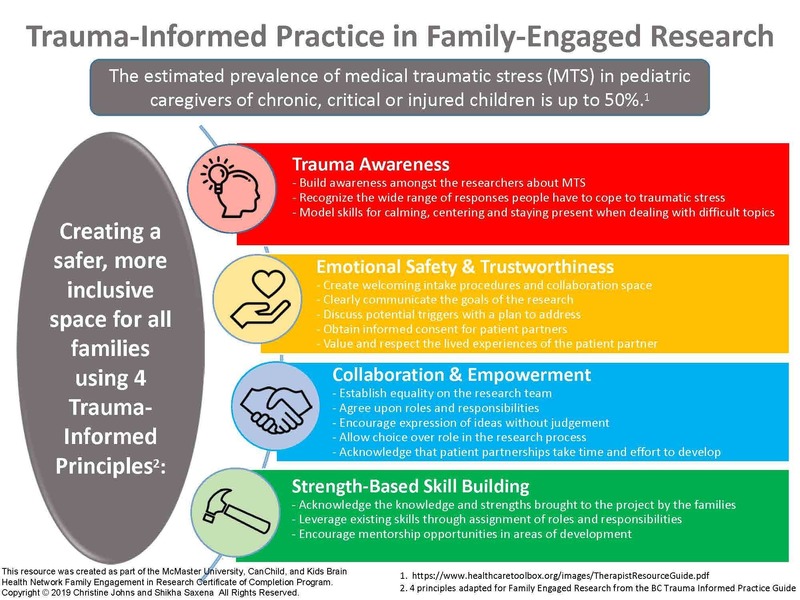
Authors: Christine Johns and Shikha Saxena
This infographic has been prepared for health researchers involved in family engaged research. It presents a rationale for utilizing trauma-informed practice in order to create a safer, more inclusive space for families to participate in health research and presents principles and strategies to assist researchers in this process.
Download the Trauma-Informed Practice in Family-Engaged Research

Authors: Sasha Dyck, Meghan Ford, and Samadhi Mora Severino
This infographic targets parents and explores parent partners' experiences in research. The infographic provides advice to other parents to overcome barriers and engage in research as collaborators. This infographic is available in English and in French.
Cette infographie est pour les parents et explore leur expériences comme partenaires en recherche. L' infographie peut être utilisée pour conseiller aux autres parents comment surmonter les obstacles et s'engager en recherche comme collaborateurs. Cette infographie est disponible en Français et en Anglais.
Authors: Kate Einarson and Lisa Raffoul
This high-level overview of guiding principles for family engagement in research (FER) was developed through conversations with a diverse group of researchers, parents, and other contributors to discuss successful research partnerships. From those conversations emerged overarching themes of Equity, Flexibility, Shared Expectations, Ethics, Empathy, and Communication, all arising from a foundation of mutual Respect. The principles, practices, and external resources in this infographic are applicable to a wide range of partnerships and projects.
Download the Guiding Principles
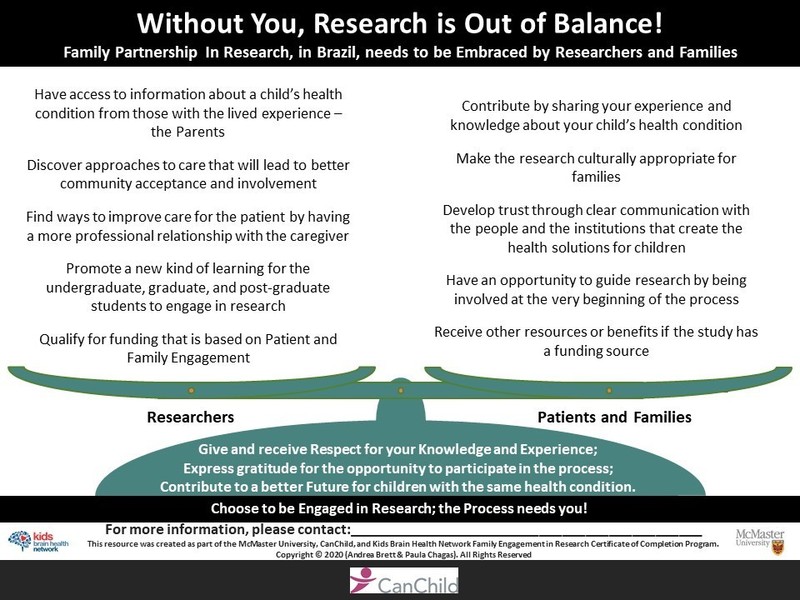
Authors: Paula Silva de Carvalho Chagas (Paula S. de C. Chagas) and Andrea Brett
Engaging families as partners throughout the research process is still in the beginning stages in Brazil. This infographic was created to highlight the importance of families choosing to engage in research and at the same time encouraging researchers to connect with and engage families. The tool was created to be culturally sensitive to the Portuguese community in Brazil and Brazilian communities in Canada as well.
Download the English Version
Envolver as famílias como parceiras em todo o processo de pesquisa ainda está nos estágios iniciais no Brasil. Este infográfico foi criado para destacar a importância das famílias escolherem se engajar na pesquisa e, ao mesmo tempo, incentivar os pesquisadores a se conectar e envolver as famílias. A ferramenta foi criada para ser culturalmente sensível à comunidade portuguesa no Brasil e também às comunidades brasileiras no Canadá.
Download the Brazilian Portuguese Version

Authors: Olaf Verschuren and Carmen Kroon
This tool is specifically tailored to parents and can be used in waiting rooms (or other areas) in rehabilitation centers or hospitals. The goal of the decision tree is to activate and/or encourage parents to sign up as a partner in research. We hope that this active approach is more effective than a more passive form of recruitment like an information letter.
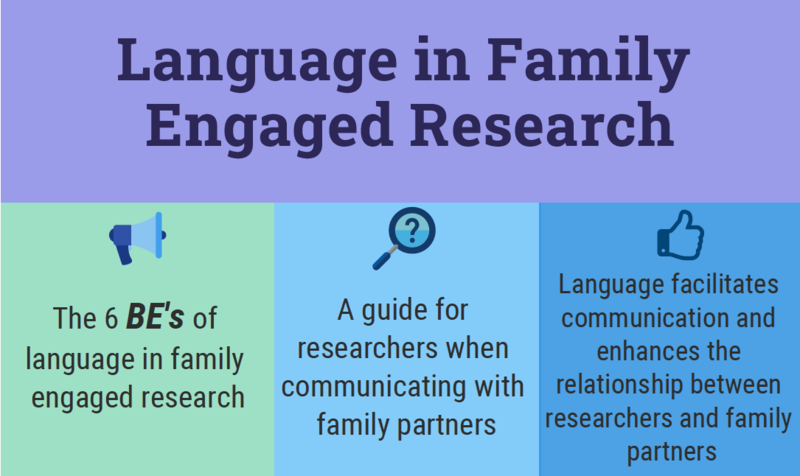
Authors: Chantel Ritter, Shannon Reaume, Karen Haas
This tool is a guide for researchers when communicating with family partners. We include six guiding principles to facilitate communication and enhance the relationship between researchers and family partners.
Download the Language in Family Engaged Research

Authors: Karys Peterson-Katz, Shona Casola, Katherine (Kate) Guzzo-Foliaro, and Deepika Sharma
The Family Engagement in Research Initial Meeting Guide provides questions to support both researchers and experience experts (families) as they begin to collaborate, co-develop relationships with each other and clarify roles before, during, and after meeting. The guide provides an overview for the first meeting by helping facilitate conversations as researchers and experience experts embark on work together. This Guide seeks to remove barriers surrounding academic language and create a bridge between roles, relationships, and responsibilities. We believe that when all sectors of health care and family care are collaborating, this will create a holistic picture of wellness and ultimately support better outcomes for children, youth, and their families.
Download the Family Partner Guide
Download the Research Partner Guide
Authors: Mackenzie Salt, Shannon Pascoe, and Rita Abdel-Baki
This Infographic has been designed to bring transparency to academic processes and pressures for potential research partners. The intent of the infographic is to illustrate these processes and pressures to support the inclusivity of patient and family partners in research.
You can download the infographic here.
Authors: Jessica Lewis, Karen Kelm, Esther Lee, and Adriel (AJ) Orena
"Roles of Experience Experts" are infographic tools adapted from the Involvement Matrix developed by Karen van Meeteren and team. The Involvement Matrix is a researcher-facing tool intended to support researchers partnering with experience experts (EE). These complementary infographics are targeted towards the EE to read on their own time. These tools provide quick, clear definitions of the potential roles available within a project in order to give EEs a better idea of the opportunities for research involvement.
You can download the infographic here.
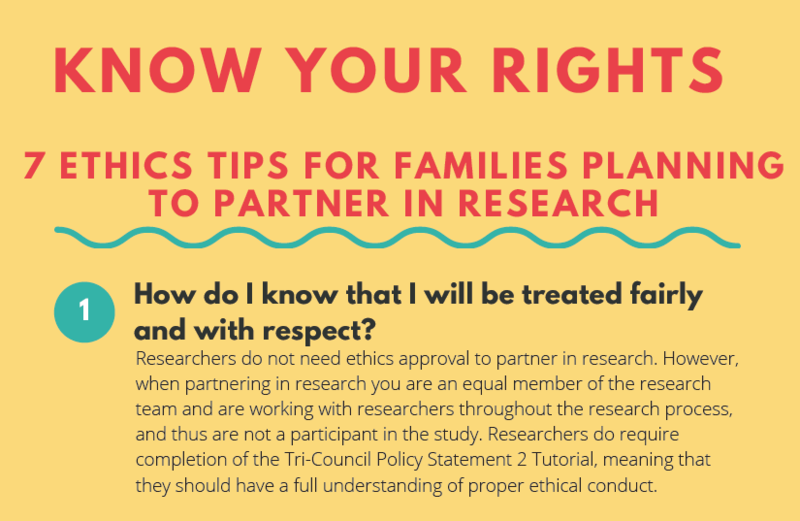
Authors: Amanda Carrington & Vanessa Tomas
This infographic provides 7 ethics tips for families planning to partner in research projects. These tips can help families ask important questions during partnership building and become more confident with engaging in research.
You can download Carrington and Tomas' infographic here.

Authors: Amanda Carrington & Vanessa Tomas
This infographic provides a roadmap example for families wishing to partner in research projects. It provides ideas for reflections, professional relationship building, and ways to become more engaged in research settings.
You can download Carrington and Tomas' infographic here.
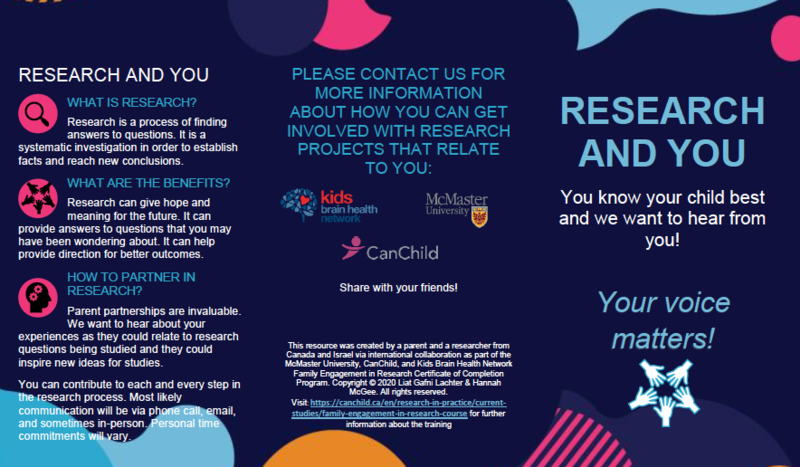
Authors: Liat Gafni Lachter & Hannah McGee
This resources provides an overview of research and the importance of family engagement. It includes ideas on how families can think about research and the steps required in the development of research projects. Feel free to download, share and print this double sided tri-fold brochure.
You can download Lachter & McGee's brochure here.

Authors: Tracey Smythe and Shaylene Pind
This tool provides guiding principles for youth and researchers that are working together on projects. It emphasizes “Your Voice Matters,” and examines five key concepts to help bridge the gaps in building connections between youth and researchers.
You can download Symthe and Pind’s guideline here.
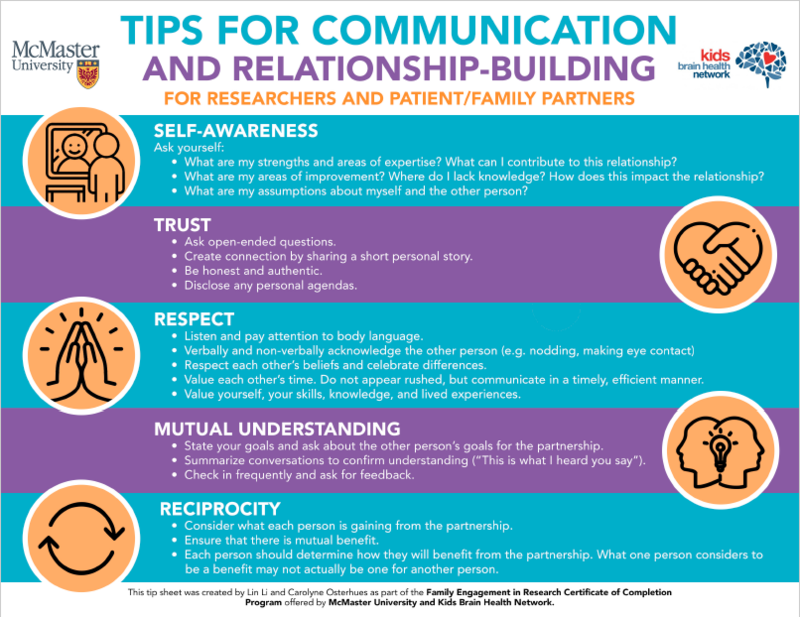
Authors: Lin Li and Carolyne Osterhues
This tool provides a comprehensive conversation guide, as well as tips for communication and relationship-building between researchers and patient/family partners. This infographic and conversation guide provides advice for various stages of the conversation, sample phrases, and tips on self-awareness, trust, respect, mutual understanding, and reciprocity.
You can download Li and Osterhues’ conversation guide and infographic here.

Authors: Yvonne Brandelli & Rebecca Nesdale-Tucker
This infographic is specifically tailored to graduate students on some of the ‘do’s’ and ‘don’ts’ of patient engagement in research. This tool focuses on seven main domains: i) learning the ropes & finding partners; ii) building relationships; iii) determining roles; iv) prioritizing questions; v) time management; vi) expenses & compensation; and vii) education.
You can download Brandelli & Nesdale-Tucker's infographic here.
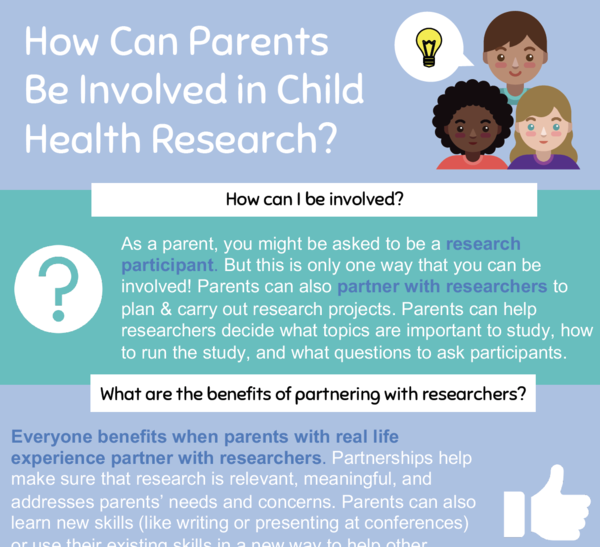
Authors: Kinga Pozniak and Perri Tutelman
This infographic provides information to family members who are interested in getting involved in child health research or who are already involved and might have some more questions about the process. The infographic addresses 5 key questions: i) How can I be involved?; ii) What are the benefits of partnering with researchers?; iii) But what if I don’t have any research training?; iv) What will I be asked to do as a research partner?; and v) Where can I learn more?
You can download Pozniak & Tutelman’s infographic here.
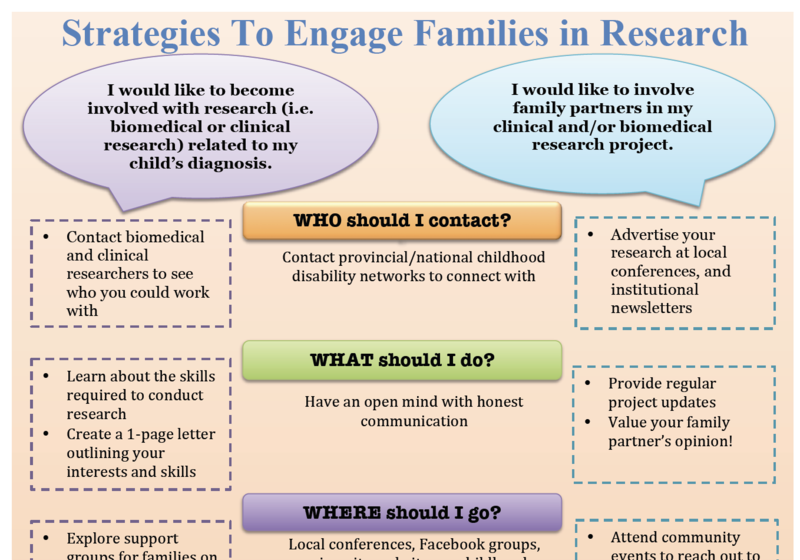
Authors: Linda Nguyen, Samantha Bellefeuille, and Lara Eid
This infographic provides tips and strategies on how to develop partnerships and enhance engagement throughout the research process. The infographic is divided in half. On one side of the page the information is directed at researchers who would like to involve family partners in their clinical and/or biomedical research project. The other side is directed to families who are interested in getting involved in either clinical or biomedical research.
You can download Nguyen, Bellefeuille & Eid’s infographic here.
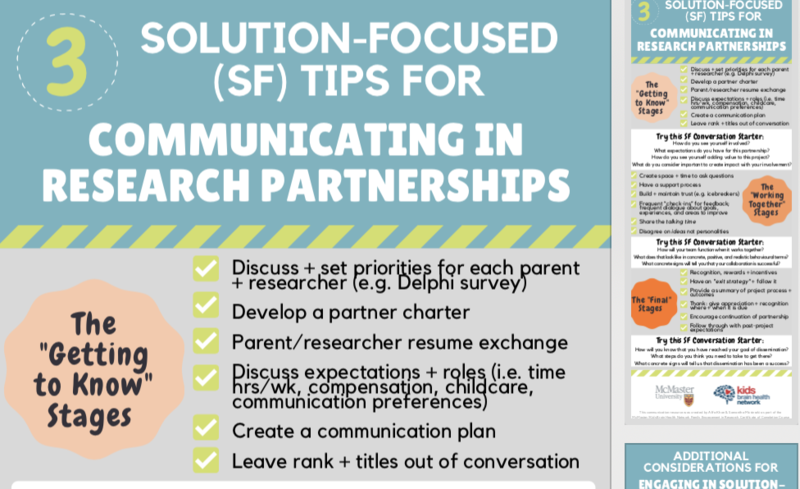
Authors: Samantha Micsinszki and Alifa Khan
This resource provides information for families and researchers on how to have solution-focused conversations in research partnerships. This tool is intended to provide strength-based, solution-focused prompts to frame conversations and to be used as a guide for families and researchers throughout the research process.
You can download Micsinszki & Khan’s infographic here.
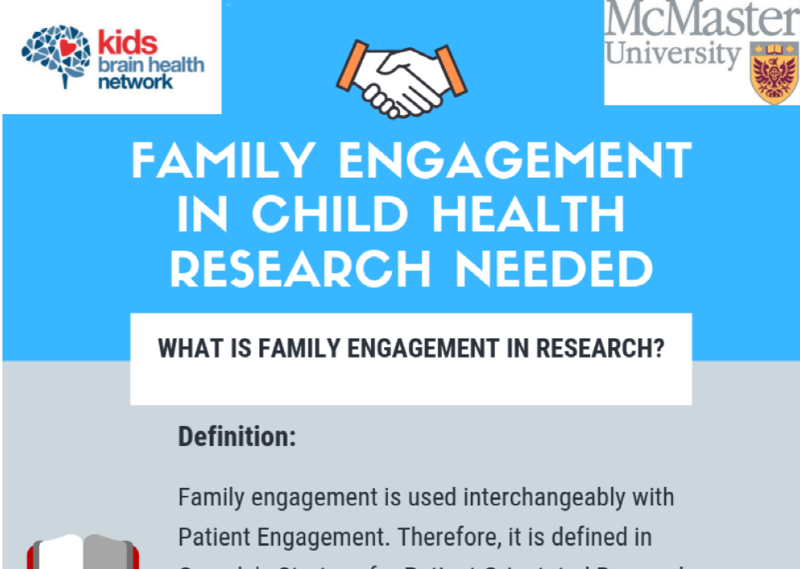
Authors: Crystal Shannon and Kirsti Mardell
This infographic highlights the need for family engagement in child health research. The infographic provides a definition of family engagement in research and then outlines the reasons for researchers and benefits for families.
You can download Shannon & Mardell’s infographic here.
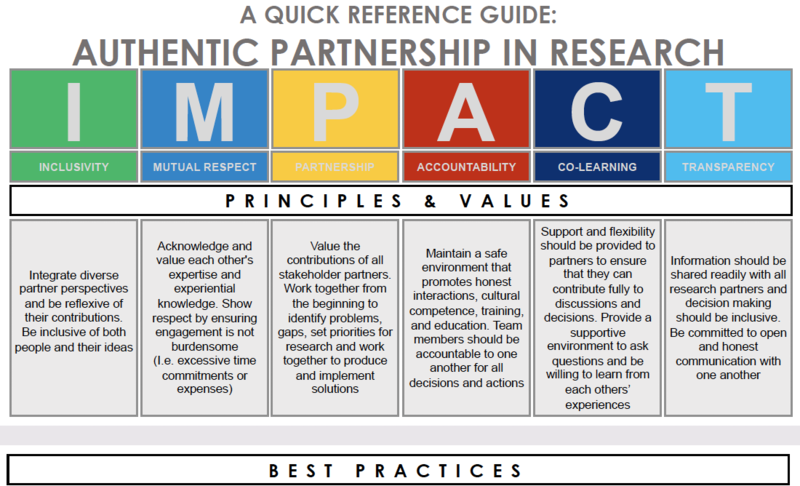
Authors: Francine Buchanan and Ayesha Siddiqua
This infographic provides a quick reference guide to authentic partnership in research, highlighting principles, values, and best practice. The authors developed the acronym ‘IMPACT’ to summarize principles and values including Inclusivity, Mutual respect, Partnership, Accountability, Co-learning, and Transparency.
You can download Buchanan & Siddiqua’s infographic here.
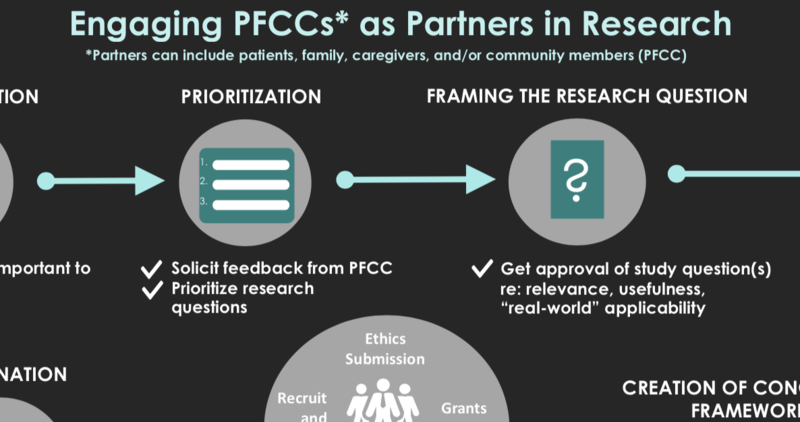
Authors: Sharon Gabison and Malvina Skorska
This infographic provides a visual pathway for researchers to showcase the process of engaging patients, families, caregivers and/or community members (PFCC) as partners throughout each stage of the research process. The authors also developed a complementary checklist and planning guide to be used in collaboration with this infographic to optimize knowledge uptake and understanding of how to establish a research partnership throughout each stage of the research process.
You can download Gabison & Skorska’s infographic here, checklist here, and planning guide here.
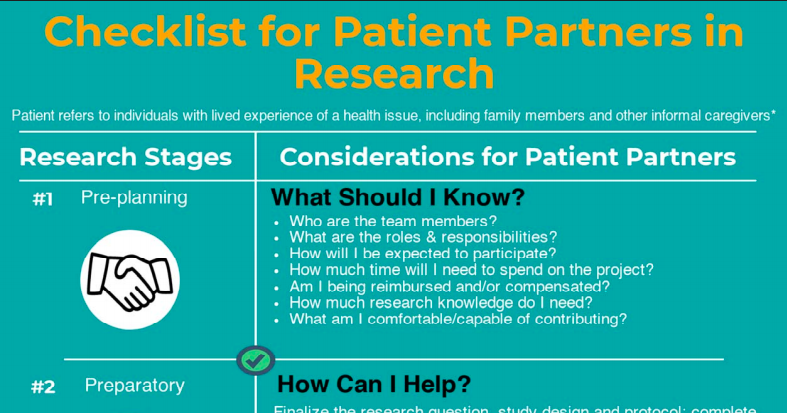
Authors: Heather Shearer and Kristina McGuire
Infographic 1 provides a checklist for patient partners in research and highlights key questions parents should ask at each stage of the research project. Infographic 2 explores patient partners’ roles in each stage of the research process.
You can download Shearer & McGuire Infographic 1 here and Infographic 2 here.
Podcasts
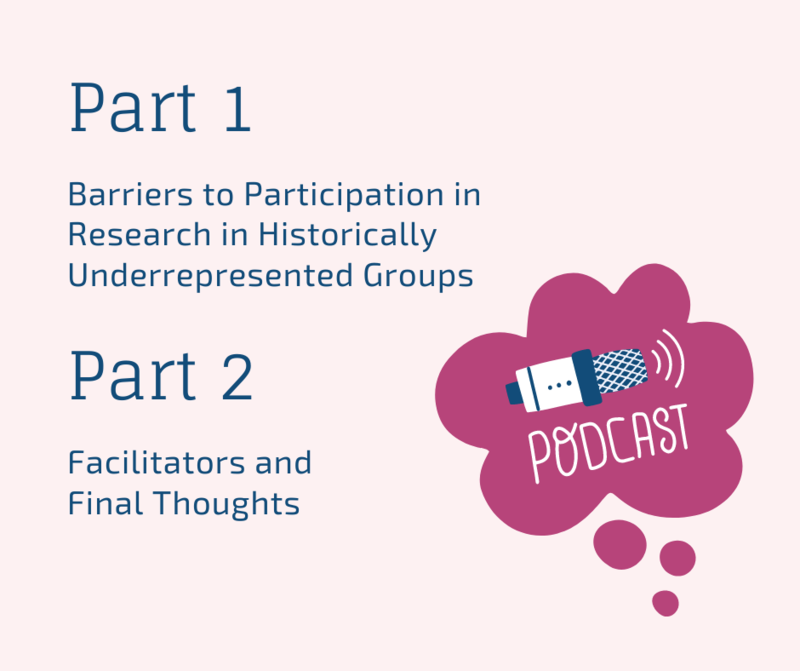
Authors: Fakhri Shafai, Nicholas Denomey, Laurel Ryan, and Jessica Baraskewich
This podcast explores the issue of engaging populations that are statistically less likely to be engaged in research. Specifically, we focus on fathers, Indigenous Canadians, newcomers to Canada, and lower-income earners. We discuss barriers to participation in these groups and strategies researchers have used to facilitate higher representation from these populations in their research.
Podcast Part 1: Barriers to Participation in Research in Historically Underrepresented Groups
Videos:
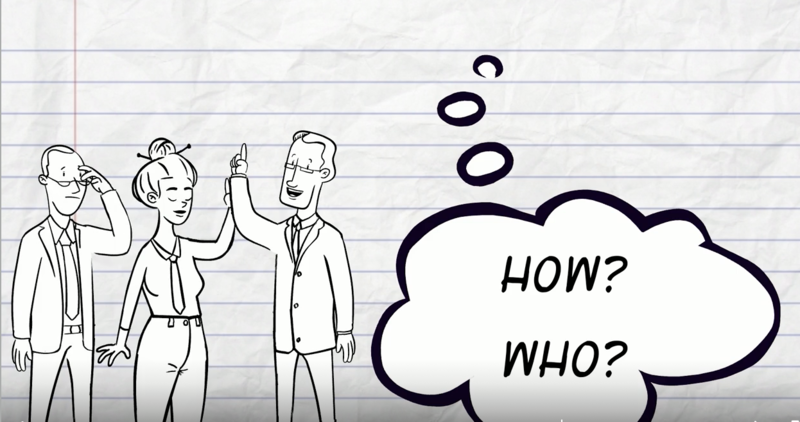
Authors: Christine Kowal, Victoria Forster, Alisha Stubbs, and Hajer Chalghoumi
The enclosed essay entitled "Research Engagement Facilitator: Bridging the gap between researchers and people with lived experience" introduces the concept of a Research Engagement Facilitator (REF) which is a unique role that serves both researchers and families to actively aid in ensuring impactful research. Included within is a job posting that describes the key attributes of the role. A short video introducing the REF role can be accessed by this link: https://www.powtoon.com/c/fk9ZZWKTsc4/1/m
Authors: Natalie del Signore, Yan Défossés, Lucy Rogers, and Roxanne Belanger
This video encourages individuals to consider participating in family engagement in research by highlighting roles, responsibilities, benefits for individuals, as well as short-term and long-term advantages for all involved. Viewers might also use this tool to start conversations on topics such as compensation and more. This video is available in both French and English.
Authors: Lisa Kakonge and Carrie Millar
Communication is the foundation for Family Engaged Research. This video explains how a tool called the Involvement Matrix can support and encourage researchers and family partners to communicate their expectations and preferred roles for a research project! Find out more about the Involvement Matrix here.
If you would like a PDF text transcript of the video, please click here.
Authors: Kristy Wolfe, Chelsea Durber, Lawrence Ng, Joanne Tay
Wonder what Family Engagement Research is all about? This video features our stories, as researchers and caregivers, of how and why we became involved in research. This I Was There Too conversation is a discussion about why it is important for families to have a seat at the research table and includes resources to help families can get involved in research.
Authors: Geneveave Barbo, Fiona Caldwell-King, and Helene Estrada
Our team developed a webinar that aims to enhance Indigenous family engagement in Fetal Alcohol Spectrum Disorder research. This webinar consists of background on FASD, barriers faced by Indigenous families, and recommendations to researchers on how to promote a collaborative partnership with Indigenous families and communities.
Authors: Meaghan Reitzel and Jennifer Crowson
This podcast showcases a conversation between a researcher and caregiver on family engagement in research. Together, they discuss ways that family members can become more involved in a research project all the way from the planning, implementing and sharing of research results.
Authors: Ara Healey and Maryann Post
We all play important roles at different stages of a research project and are equally important to the success of the team. This video looks at re-defining roles in research and its impact on both the team and the research project.
Authors: Mindy Silva and Jen Appelton
This video explores the true meaning of family engagement in research, and what it looks like in practice from the initial conception to the final results/knowledge dissemination. Useful resources to support family engagement in research are highlighted throughout the video.
Download the Communication Toolbox for Optimizing Family Engagement in Research
Authors: Danijela Grahovac, Vivian Lee, and Sara Izadi-Najafabadi
This video - Day in the Life of Parent Researcher: An Interview, is an interview with Danijela Grahovac, a parent researcher with CanChild and mother to a teenager with Cerebral Palsy. This interview provides real-life examples and information about Danijela’s experiences as a parent researcher and why and how other parents can consider becoming engaged in child health research.
Authors: Karen van Meeteren and Kaitlyn McLachlan
This is a brief 3-minute informational video introducing what family engagement in research is and why it is important. This video is easy to share over social media to help spread the word about the importance of family engagement.

